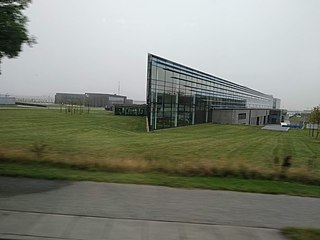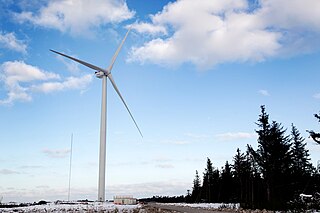
A windmill is a structure that converts wind power into rotational energy using vanes called sails or blades, by tradition specifically to mill grain (gristmills), but in some parts of the English-speaking world, the term has also been extended to encompass windpumps, wind turbines, and other applications. The term wind engine is also sometimes used to describe such devices.

Horns Rev is a shallow sandy reef of glacial deposits in the eastern North Sea, about 15 km (9.3 mi) off the westernmost point of Denmark, Blåvands Huk. The reef contains the Horns Rev Offshore Wind Farm.
Ørsted A/S is a Danish multinational energy company. Headquartered in Fredericia, Denmark, Ørsted is the largest energy company in Denmark. The company adopted its current name on 6 November 2017. It was previously known as DONG.

Vestas Wind Systems A/S is a Danish manufacturer, seller, installer, and servicer of wind turbines that was founded in 1945. The company operates manufacturing plants in Denmark, Germany, the Netherlands, Taiwan, India, Italy, Romania, the United Kingdom, Spain, Sweden, Norway, Australia, China, Brazil, Poland and the United States, and employs 29,000 people globally.

Denmark was a pioneer in developing commercial wind power during the 1970s, and today a substantial share of the wind turbines around the world are produced by Danish manufacturers such as Vestas—the world's largest wind-turbine manufacturer—along with many component suppliers. Furthermore, Denmark has—as of 2022—the 2nd highest amount in the world of wind power generation capacity installed per capita, behind only neighboring Sweden.
Siemens Gamesa Renewable Energy, S.A. was formed in 2017 in a merger of Siemens' Wind Power division with Gamesa Corporación Tecnológica, S.A.; it is a Spanish-German wind engineering company based in Zamudio, Biscay, Spain. The company has two other main sites in Spain: one in Madrid and the other in Sarriguren. Other than its headquarters, its onshore business is primarily based in Spain, while the offshore business is based in Germany and Denmark. It is the world's second largest wind turbine manufacturer behind Vestas.

The Nysted Wind Farm is a Danish offshore wind farm close to the Rødsand sand bank near Lolland. Gravity base foundations are used rather than piles due to ice conditions.

The Burbo Bank Offshore Wind Farm is a 348 MW offshore wind farm located on the Burbo Flats in Liverpool Bay on the west coast of the UK in the Irish Sea. It consists of an original 90 MW wind farm commissioned in 2007 and a 258 MW extension completed in 2017.

DanTysk is a 288 megawatt (MW) offshore wind farm in the North Sea 70 kilometres (43 mi) west of the island Sylt, in the German EEZ at the border to Denmark. The wind farm operates 80 Siemens Wind Power's SWT-3.6-120 turbines with a capacity of 3.6 MW each.

Blyth Offshore Wind Farm was a small coastal wind farm located 0.5 miles (0.80 km) off the coast of Blyth, Northumberland, England.

Anholt Offshore Wind Farm is a Danish offshore wind power wind farm in the Kattegat, between Djursland and Anholt island. With a nameplate capacity of 400 megawatts (MW), it is one of the largest offshore wind farm in the world and was the largest in Denmark from 2013 to 2019. A cable from the wind farm to Anholt replaces most of the diesel-powered electricity on the island.

Westermost Rough Wind Farm is an offshore wind farm 8 kilometres (5 mi) north east of Withernsea off the Holderness coast, in the North Sea, England. The farm covers an area of approximately 35 km2 (14 sq mi) with a generation capacity of approximately 210 MW. It became operational in May 2015.

The Vestas V164 is a three-bladed offshore wind turbine, produced by Vestas, with a nameplate capacity of up to 10 megawatts, a world record. Vestas revealed the V164's design in 2011 with the first prototype unit operated at Østerild in northern Denmark in January 2014. The first industrial units were installed in 2016 at Burbo Bank, off the west coast of the United Kingdom. By 2021, Vestas had produced 500 of the series.

Østerild Wind Turbine Test Field is a facility managed by the DTU Risø Campus of the Technical University of Denmark (DTU) for testing of offshore wind turbines with a pinnacle height up to 330 metres (1,080 ft) near Thisted-Østerild, Denmark.

Henrik Stiesdal is a Danish inventor and businessman in the modern wind power industry. In 1978, he designed one of the first wind turbines representing the so-called "Danish Concept" which dominated the global wind industry through the 1980s. Until 2014, Stiesdal was the chief technology officer of Siemens Wind Power. During his professional career, Stiesdal has made more than 175 inventions and has received more than 650 patents related to wind power technology.

Tunø Knob Offshore Wind Farm is an offshore wind farm in the Bay of Aarhus, Denmark. It is located on the sandbar Tunø Knob, west of the Tunø island.

Hywind Scotland is the world's first commercial wind farm using floating wind turbines, situated 29 kilometres (18 mi) off Peterhead, Scotland. The farm has five 6 MW Siemens direct-drive turbines on Hywind floating monopiles, with a total capacity of 30 MW. It is operated by Hywind (Scotland) Limited, a joint venture of Equinor (75%) and Masdar (25%).

Horns Rev is an offshore wind farm in Danish waters in the North Sea.
















